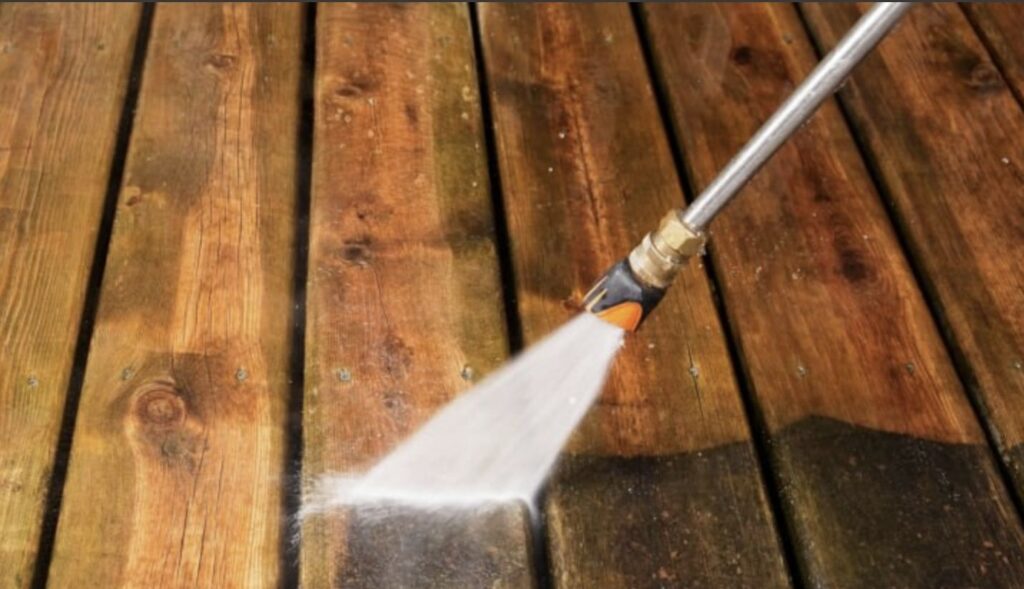Ultimate Guide: How to Remove Paint from Your Deck
Removing paint from a deck can be daunting, but with the right approach, you can restore your wood to its original beauty. This guide will walk you through every step of the paint removal process, ensuring your deck looks as good as new. Whether you’re dealing with peeling paint or just want to switch up your deck’s color, we’ve got you covered.
Note: It is essential to remember that Composite decks or PVC decks should not be painted. These low-maintenance materials have a polymer coating that protects them from damage and retains their color, eliminating the need for painting or sealing.
Prepping Your Deck: Getting Ready for Paint Removal

Before you start, it’s essential to prepare your deck properly. Clear the area of all furniture, plants, and other items. Give your deck a thorough cleaning to remove dirt, grime, and any loose paint chips. This initial step is crucial for ensuring the paint removal process is effective.
Choosing the Right Paint Remover: Chemical vs. Manual Methods
When it comes to removing paint from wood, you have two primary options: chemical paint removers and manual methods. Chemical removers can be very effective but require careful handling and safety precautions. Manual methods, such as sanding or using a heat gun, might take more effort but can be just as effective with the right technique. Weigh the pros and cons of each method to determine which is best for your situation.
Tools and Materials Needed
The tools required depend on the paint removal method you choose. Select the appropriate tools and materials based on the chosen paint removal method.
Tools:
Personal protective equipment (PPE)
• Paint roller/brush (gel paint stripper)
• Sprayer (liquid paint stripper)
• Scraper
• Power Washer
• Random orbital or belt sander)
• Nylon-bristle brush
Materials
• Paint stripper (if chemically removing paint)
• Sandpaper
Applying Chemical Paint Removers: Step-by-Step Process
If you opt for a chemical paint remover, follow these steps for best results:
• Safety First: Wear protective gear, including gloves and goggles.
• Apply Remover: Spread a thick layer of the chemical remover on the painted areas.
• Wait: Allow the remover to sit for the recommended time, usually indicated on the product label.
• Scrape Off Paint: Use a paint scraper to gently remove the loosened paint.
Rinse: Wash the area with water to neutralize the chemicals and remove any residue.
Eco-Friendly Options: Natural Paint Removal Methods
For those looking for environmentally friendly options, consider these natural methods:
• Vinegar: Heat vinegar and apply it to the paint with a brush. Let it sit, then scrape off the paint.
• Baking Soda: Create a paste with baking soda and water. Apply it to the paint, let it dry, and then scrub it off.
• Soy Gel Removers: These biodegradable products are effective and gentle on the environment.
• Sanding: Sanding is a reliable method for removing paint from wood. Remember to choose the right Sandpaper for your deck: Softwoods: 80-100 grit sandpaper; Hardwoods: 100-120 grit sandpaper
Post-Removal Care: Preparing Your Deck for a Fresh Look

After removing the paint, it’s important to prepare your deck for its new finish:
• Inspect the Wood: Check for any damage or rough spots that need sanding or repair.
• Clean the Deck: Give it a final clean to remove any dust or debris.
• Seal or Stain: Apply a wood sealer or stain to protect your deck and enhance its natural beauty.
Avoiding Common Mistakes: Tips for Successful Paint Removal
To ensure a smooth paint removal process, keep these tips in mind:
• Test First: Always test your chosen method on a small, inconspicuous area first.
• Don’t Rush: Allow adequate time for removers to work and for the wood to dry between steps.
• Stay Safe: Use protective gear and follow all safety instructions for the products and tools you use.
Enjoying Your Revitalized Deck
With the paint removed and your deck freshly finished, it’s time to enjoy your revitalized outdoor space. Regular maintenance, such as cleaning and resealing, will keep your deck looking great for years to come.
Tips: If you don’t want to spend much time and effort maintaining wood deckings, choosing composite decking can save you the trouble of painting.
Comparing wood decking to composite decking, the advantages of Oakio Advanced Composite Decking stand out. These manufactured materials don’t need sanding or sealing and can last over 50 years. This translates to less time and money spent on annual maintenance, and you’ll never need to learn how to remove paint from your deck.
Order free decking samples to experience the superior quality of Oakio Decking for yourself.
Trending Reading
What Are the Differences Between the WPC Board and PVC Board?
[2024 Update] How Long Does WPC Decking Last?











